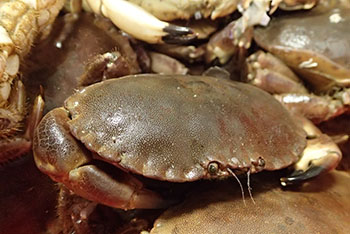Fishery
Fishery
Edible Crabs (Cancer pagurus):
Cancer pagurus is caught in pots around most of the British Isles. Catches have risen steadily over the past 40 years and most of the British catch is exported live to France and Spain.
Species Ecology
Species Ecology
 The Brown Crab or Edible Crab (Cancer pagurus)
The Brown Crab or Edible Crab (Cancer pagurus)
The edible “brown crab” has an oval, reddish brown carapace with a distinctive “pie crust” edge and black tipped pincers. Adults can grow to 25 cm wide, weigh up to 3kg and live as long as 30 years.
Habitat & Distribution
Brown crabs are abundant throughout British and Irish coastal waters; they can be found as far north as Norway and as far south as Africa. Brown crabs use a variety of coastal habitats during different stages in their life history, from intertidal algae beds to mixed coarse sediments and offshore in muddy sands in water as deep as 100m.
Life cycle
Male crabs will grab a female and guard her until she moults, which is when her carapace becomes soft, and she can be fertilised. After mating the female will retreat to soft sediments to brood her millions of eggs for anywhere up to nine months. The number of eggs will depend on the size of the mother and the development time is temperature dependant. Tiny larvae (1 mm) called zoea will hatch and go through several moults themselves before metamorphorphising into a postlarval form called a megalopa. This megalopa stage will settle out of the water column and into juvenile habitats inshore. Juveniles will stay in the intertidal zone until they reach 60-70 mm at which point they will migrate to deeper waters. Size at sexual maturity appears to vary with region and a range of sizes has been reported for both males (101-117mm carapace width) and females (108-134 mm carapace width).
The European spider crab (Maja squinado & Maja brachydactyla)
It has been revealed that the Mediterranean spider crab is distinct from the Atlantic with Maja squinado found in the Mediterranean and Maja brachydactyla more commonly found in the Atlantic. The spider crab is a large crab with a circular, convex carapace bordered with spines. It can be red, brownish-red or yellow in colour and is often covered in attached algae. This species can grow to be 20 cm long.
Habitat & Distribution
It is found on coarse sand mixed sediments and bedrock along the open coast, as well as in deep tide pools and in shallow water up to 50 m in depth. It is found in the north-east Atlantic and the Mediterranean Sea. It has a varied diet, with seaweed and molluscs dominant in the winter, and species such as sea urchins and sea cucumbers in the summer. They undergo seasonal migrations, leaving coastal nursery areas in autumn/winter. They then head to their overwintering sites offshore at depths of over 50 m and return to their nursery areas in spring.
Life Cycle
The life cycle of European spider crab is between 5 and 8 years, and consists of a growth phase and a reproductive phase. The growth phase lasts 2-3 years. The tiny larvae develop in the water column before settling as juveniles on the seabed. The reproductive stage begins after a final moult and the crab may live up to 6 more years.